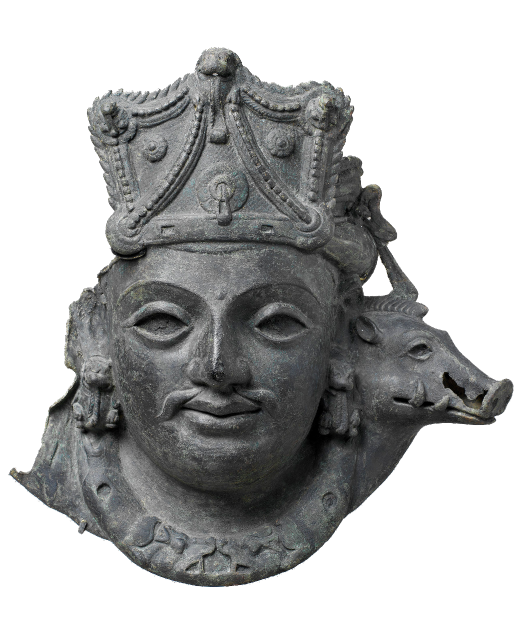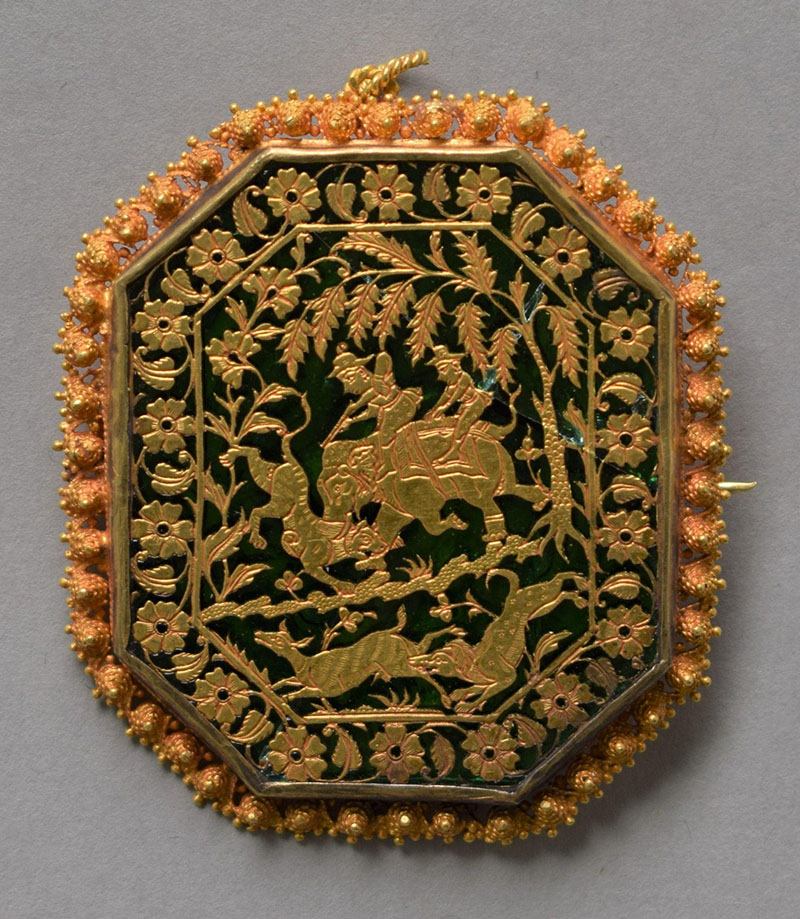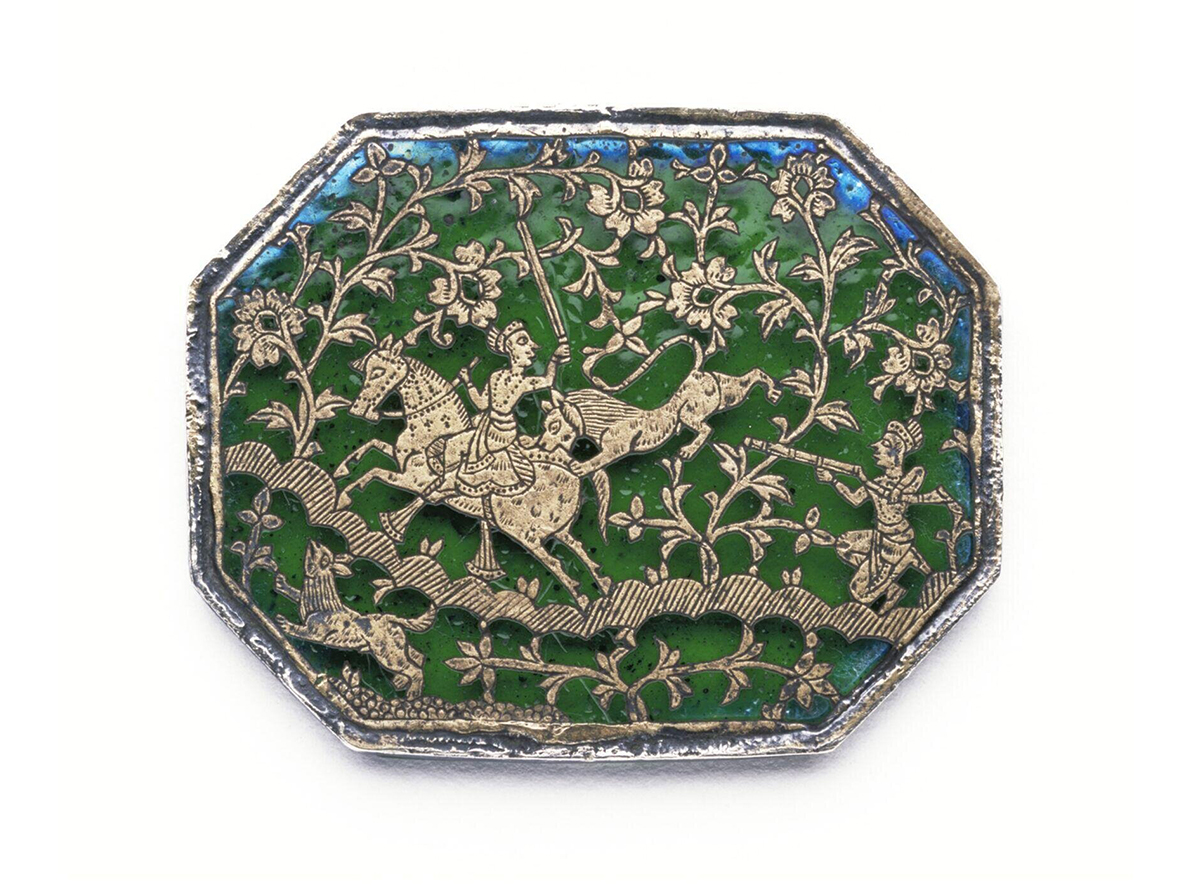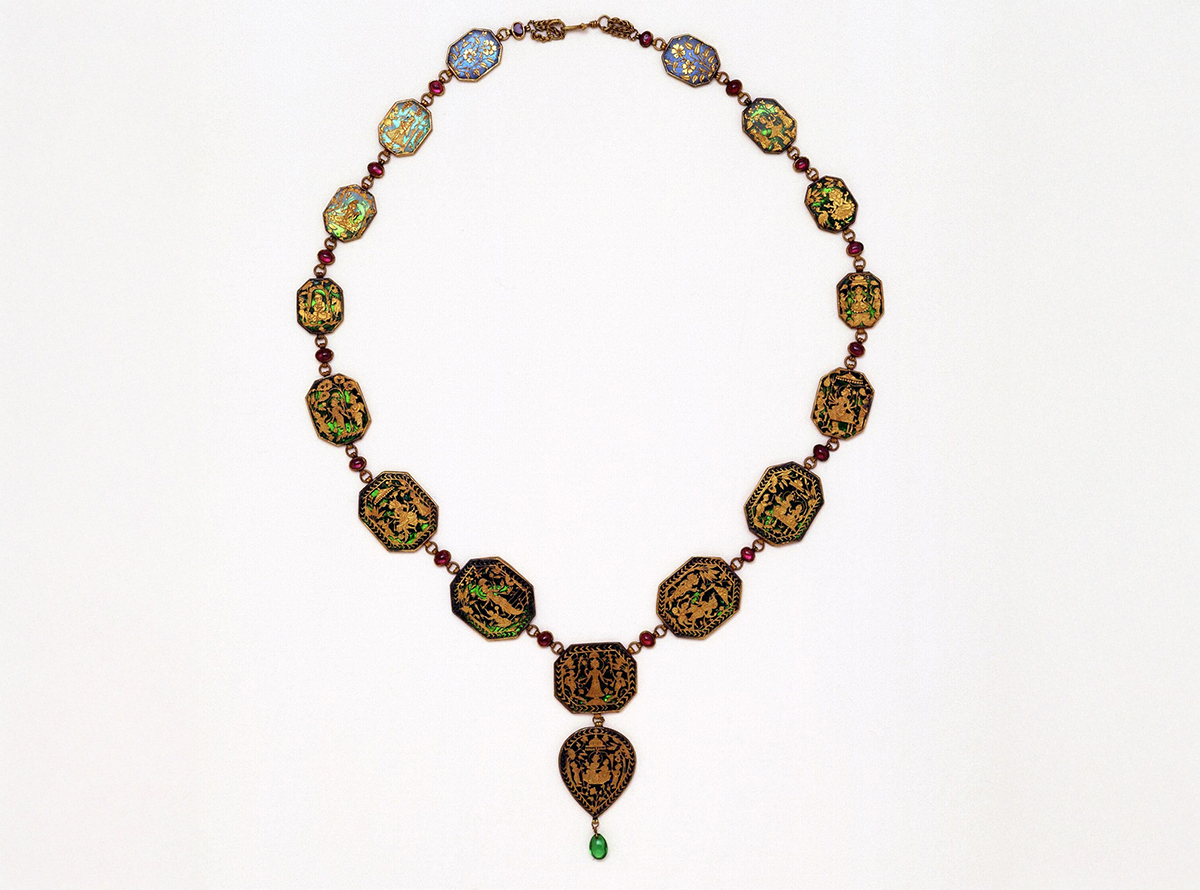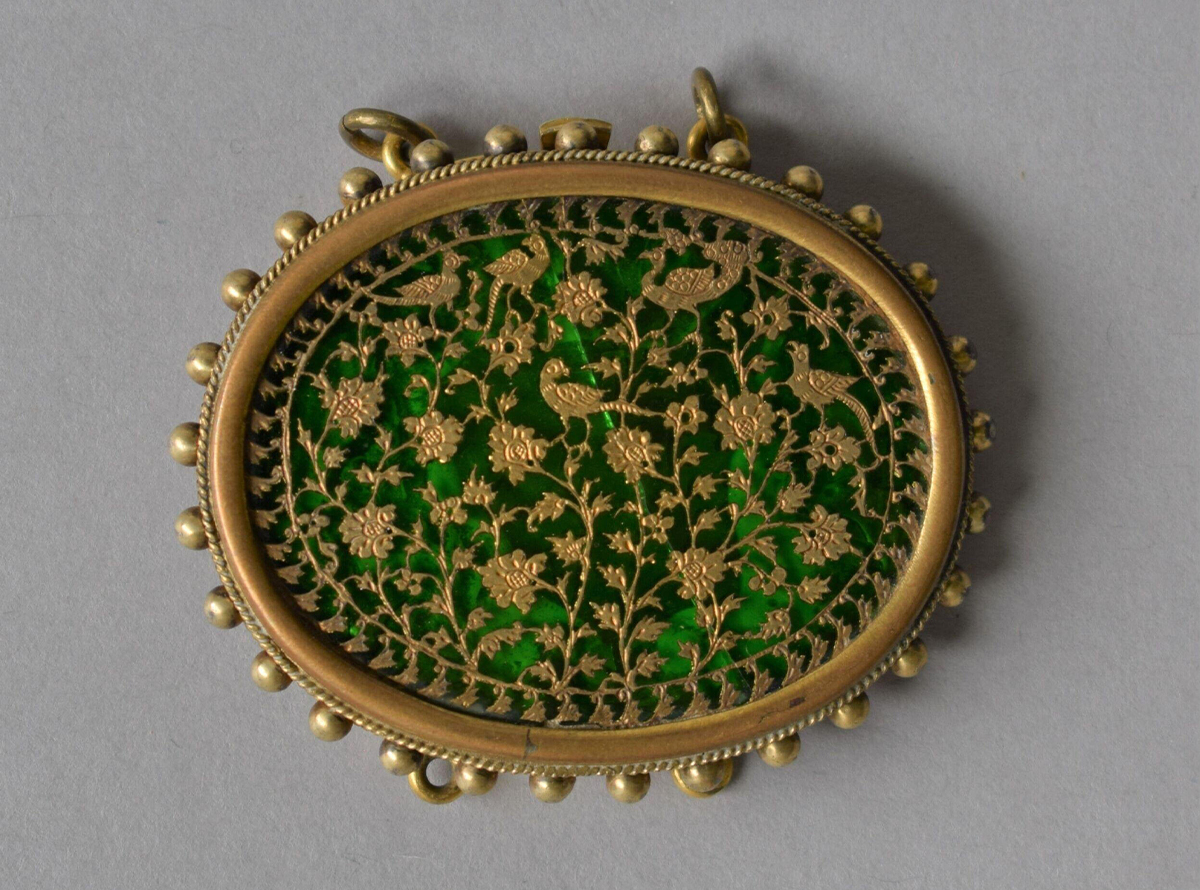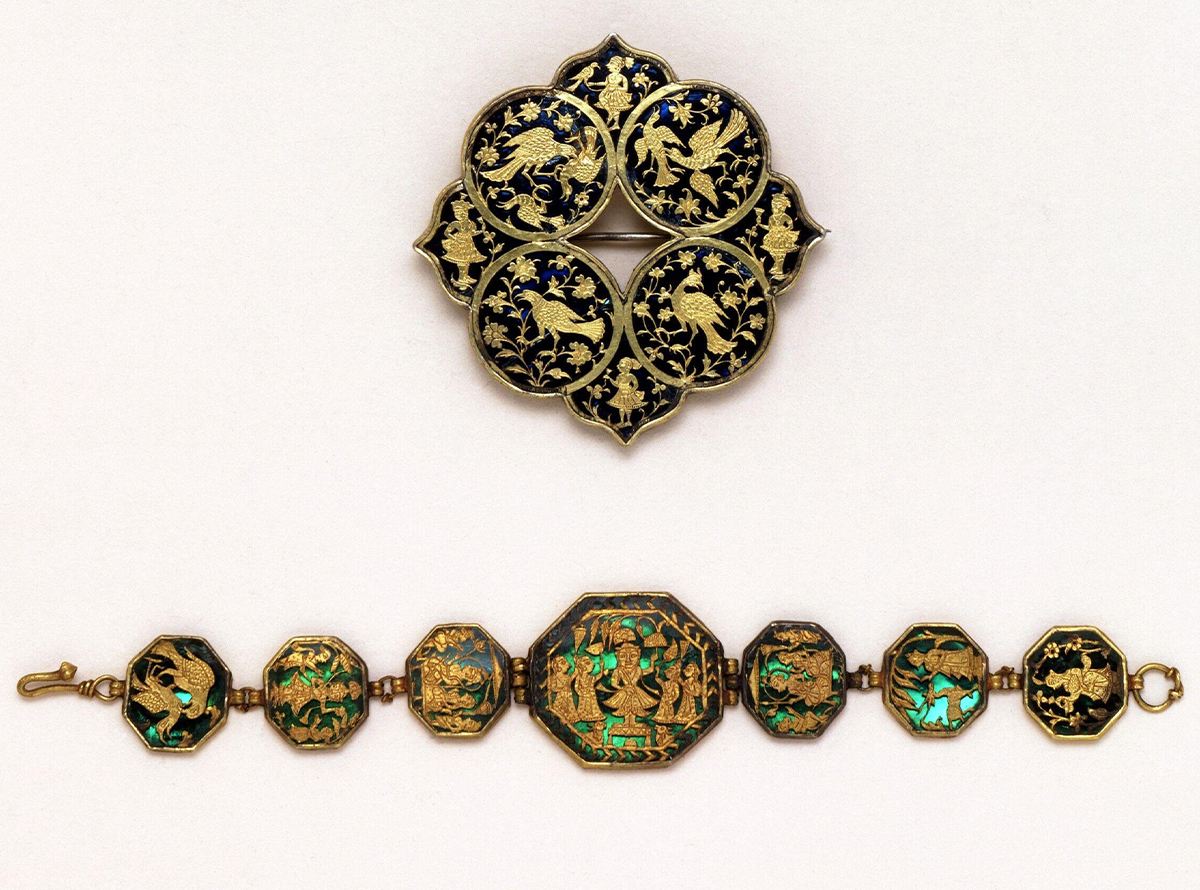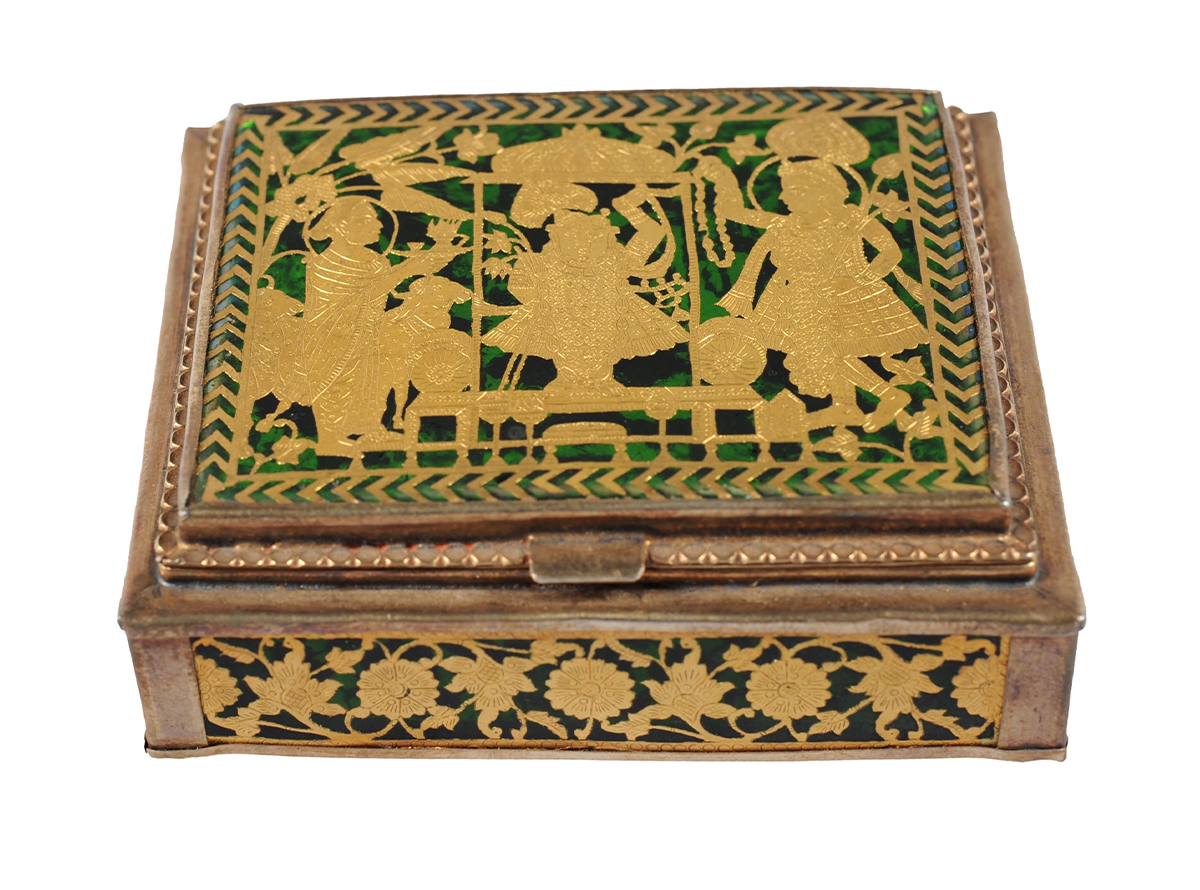ARTICLE
Thewa
Thewa artisans, including Nathu Lal’s descendants, continue to practice the craft in Pratapgarh district. Details of the craft have been kept secret among the men of these families, on the assumption that women might divulge the process to the family they marry into. Jewellery featuring thewa pieces is still made and sold in Pratapgarh — popular items include chokers, hairpins, earrings, rings, bangles, and waistbands or belts (kamarband). Thewa pieces are also seen on domestic objects such as betel-quid boxes (paandan) or trays, and spice boxes, and ritual objects such as rosewater sprinklers (gulabdan), shrines, and containers for idols.
Process
Given the secrecy maintained around aspects of the craft, much of the available information about the thewa technique comes from limited insights from interviews with artisans and scholars’ deductions from careful examination of finished thewa pieces.
The process begins with therna — beating a piece of high-purity gold — usually 23 or 24 karat — into a very thin leaf using a pestle-like iron tool (aeran), to match the dimensions of the glass ground to which it will be fused. In order to carve it, the leaf is often soldered into a silver wireframe (vaada) and laid over a wooden board freshly coated with lac resin. Care is also taken during the application of resin on the board to avoid bubbles, which can leave unwanted impressions on the gold leaf. The design is then etched onto the gold leaf using a thin, pointed metal scriber (sui). Details are created with various chasing punches (chheni) — each with a different shape or pattern — lightly hammered using a slim wooden or metal rod. The tools are made by the artisans themselves to suit their needs.
The piercing itself takes place in the next stage, known as kantaarna, in which negative spaces of the etched design are removed — leaving the periphery uncut — to create the openwork or jaali through which the coloured glass will be visible. Piercing is done with small chisels (tankla) that, like the chasing punches, are variously shaped to achieve different effects. The excess gold from the piercing and from outside the frame is saved and reused. The lac is then warmed to separate it from the now-complete openwork gold leaf, known as thewa ki patti (‘thewa leaf’), and the impression of the design left on the lac is transferred onto paper using lampblack, to serve as a record for future pieces.
The gold leaf is cleaned, dried, and placed on a piece of flat coloured glass, typically 3 mm thick and cut in the standard shapes and contours of gemstones: round, drop-shaped, oval, square, rectangular, or octagonal. Red, green or blue glass is typically used, in order to mimic ruby, emerald and sapphire. The piece, placed on a base of mica in a small clay crucible (kuthali) filled with sand and ashes, is heated over a charcoal hearth for the gold to melt and fuse onto the glass. The temperature is increased by blowing onto the embers through a long brass pipe (punkna); the glass turning red hot indicates that the gold has fused onto it. The crucible is then removed from heat and the thewa piece is left to cool slowly; rapid cooling would cause the glass to shatter. In the finished piece, the glass retains its shine and smoothness, and the gold, because of its purity, shows no discolouration from the heat.
Once fused and cooled, the thewa piece is set in a metal-backed bezel, typically of gold-plated silver or brass; however, a thin, brightly polished piece of silver or tin foil is placed beneath the glass to reflect light and intensify its colour. It may then be additionally decorated with pearls, gold bands, chains, or other elements.
Motifs
The motifs seen on thewa pieces have evolved over time. Common religious or mythological motifs include Srinathji, a Vaishnava deity widely worshipped in western India, scenes of Krishna and his consort Radha, images of Shiva or a mother goddess, and characters from the Ramayana such as Rama, Sita, Rama’s brothers, and Hanuman. Thewa pieces also feature foliage and flowers (phul-patti), birds, domestic scenes of huts with animals (jhompra-patti), hunting scenes showing jungles (shikargah), and historical figures, commonly Maharana Pratap Singh and his legendary horse Chetak. The imagery is often borrowed or inspired by other small-scale, intricate art forms such as miniature painting. Historically, specially commissioned Thewa pieces, typically portraits (tasvir), were exchanged as gifts between rulers of various princely states and have been given to members of the British royal family. Today, images of individual animals, most often elephants and peacocks, as well as repeating floral patterns and Tree of Life motifs are common.
Historical thewa artefacts are preserved in collections around the world, including the Chhatrapati Shivaji Vastu Sangrahalaya, Mumbai; the Royal Collection, UK; the Victoria and Albert Museum, London; and the Metropolitan Museum of Art, New York. The craft received a Geographical Indication tag in 2011. Notable thewa artisans include Beni Ram Soni and Jagdish Lal Soni, who won the Shilp Guru award in 2002 and 2003, respectively. In 2002 the Government of India issued a postal stamp featuring a thewa plate by Girish Rajsoni; he was later given the Shilp Guru award in 2015.
Bibliography
Krishnan, Usha R., and Sushil Kumar, Meera. Indian Jewellery: Dance of the Peacock. Mumbai: India Book House. 2001.
The Metropolitan Museum of Art. “Bracelet.” Accessed December 15, 2022. https://www.metmuseum.org/art/collection/search/451629.
Ranjan, Aditi, and M. P. Ranjan. Handmade in India: Crafts of India. New Delhi: Mapin, 2007.
Royal Collection Trust. “Necklace.” Accessed December 16, 2022. https://www.rct.uk/collection/11499/necklace.
“Set in Gold & Glass.” Deccan Herald, April 7, 2018. Accessed December 15, 2022. https://www.deccanherald.com/content/668982/set-gold-glass.html.
“Thewa Art Work: GI Application No. 244.” Geographical Index Journal, no 54 (November 28, 2013): 93–98. https://search.ipindia.gov.in/GIRPublic/Application/Details/244.
Untracht, Oppi. “Distinctive Goldsmith Techniques.” Traditional Jewellery of India. London: Thames & Hudson. 1997.
